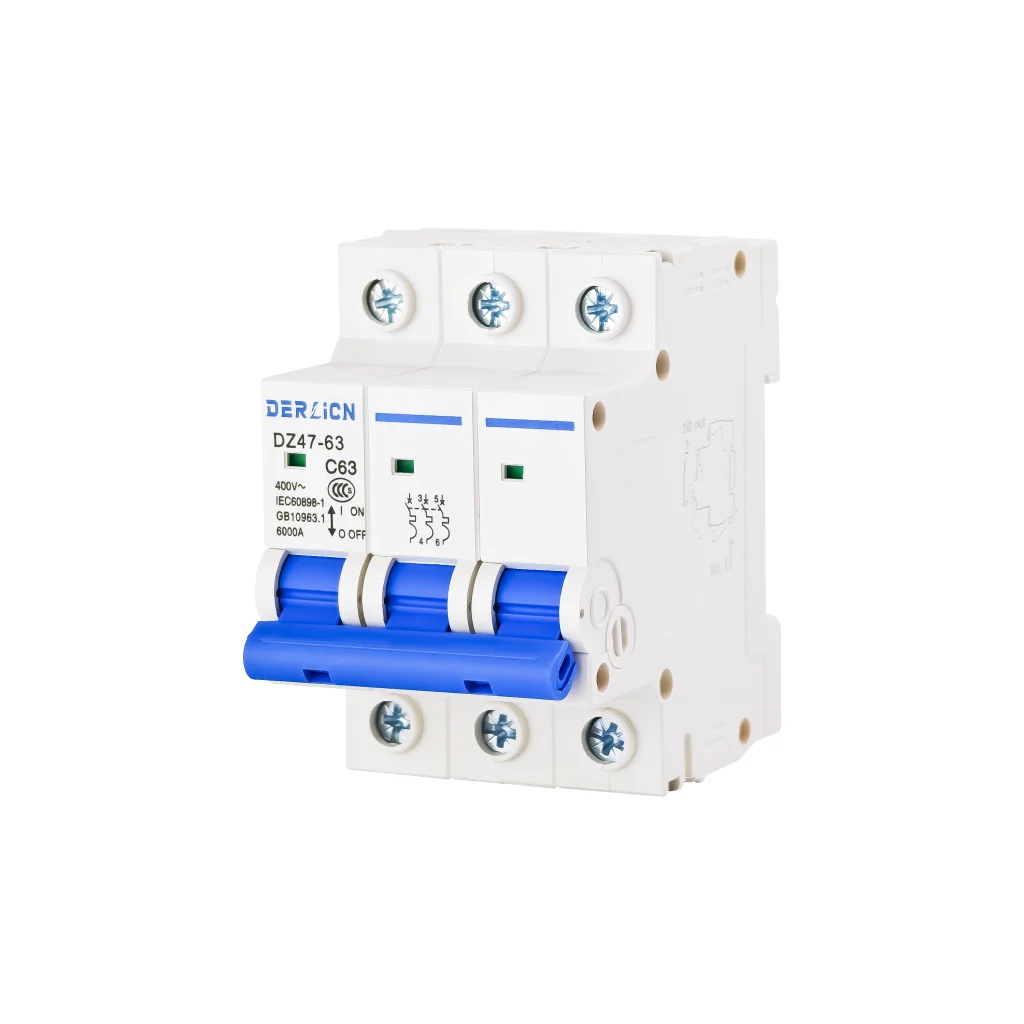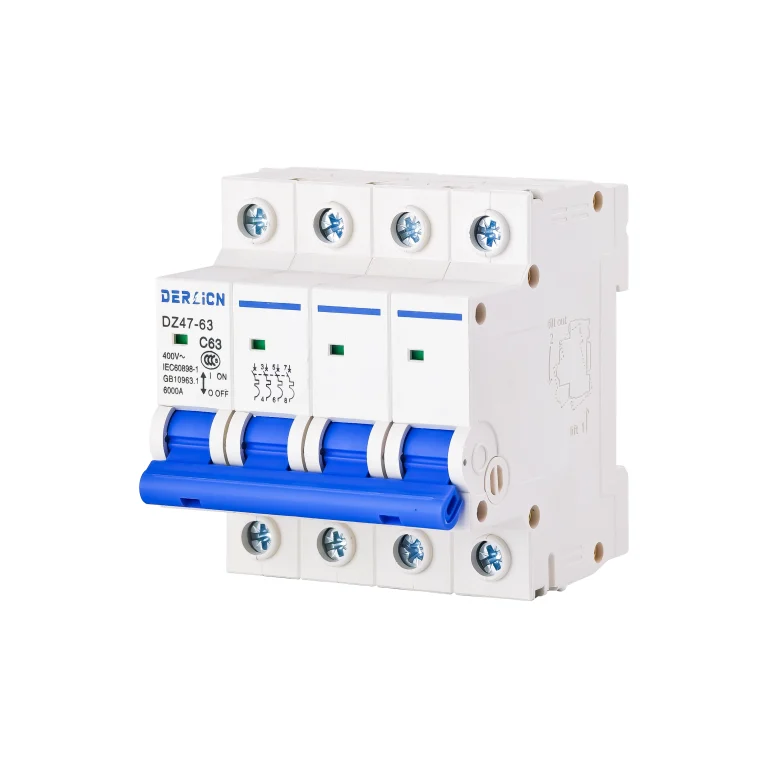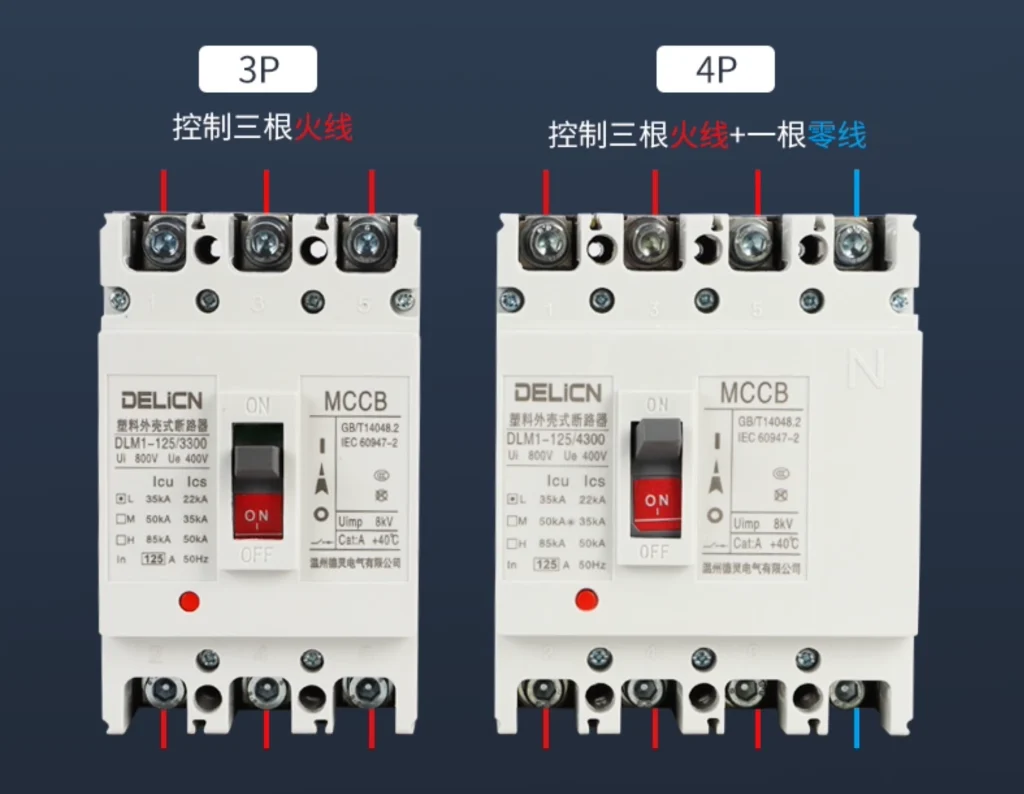In low-voltage power distribution systems, selecting the right type of circuit breaker is essential—not only for safety but also for system compatibility and operational efficiency. Among the most common choices are 3-pole and 4-pole circuit breakers. Although they may appear similar in form, their functions, applications, and implications for protection differ significantly.
Many customers ask: “Do I really need a 4-pole circuit breaker, or will a 3-pole be sufficient?” The answer depends on your system’s grounding method, neutral management, and the type of load you’re dealing with. Understanding the technical distinctions between the two can help ensure you make the right choice for your project.


When selecting a circuit breaker, one of the first technical specifications to consider is the number of poles. The pole count—ranging from 1 to 4 poles—refers to the number of separate conductive paths that can be simultaneously protected and disconnected by the breaker. Choosing the correct number of poles is critical for ensuring both safety and functionality in your electrical system.
A 1-pole breaker is typically used in single-phase, 2-wire systems (line + neutral), and provides protection for one hot wire. It’s most common in residential lighting or socket circuits.
2-pole breakers are used in single-phase, 3-wire systems (L+N+PE), where both live and neutral conductors need to be disconnected, often in 240V applications.
A 3-pole breaker is standard for three-phase, 3-wire systems, providing protection for all three phases. It does not switch the neutral, making it suitable for balanced loads that do not require neutral disconnection.
In contrast, a 4-pole breaker is used in three-phase, 4-wire systems, offering simultaneous switching of the three phases and the neutral conductor. This is essential for systems with unbalanced loads, high neutral currents, or where complete disconnection is required for safety and compliance.
Understanding the difference between 3-pole and 4-pole breakers—particularly in low-voltage power distribution—can help ensure your installation meets both performance and protection requirements. Let’s explore how these two configurations differ in application and function.

What Is a 3-Pole Circuit Breaker?
A 3-pole circuit breaker is designed to interrupt all three phases—L1, L2, and L3—in a three-phase electrical system. It is most commonly used in three-phase, three-wire (3W) configurations where there is no neutral conductor, such as in balanced industrial motors or resistive heating loads.
In such systems, the current flowing through each phase is usually symmetrical, and since there’s no need to switch or protect the neutral, a three-pole breaker provides both mechanical and thermal-magnetic protection for the active phases. This type is widely adopted in factories, commercial buildings, and control panels where a neutral is not required.
How Is a 4-Pole Circuit Breaker Different?
The 4-pole circuit breaker is essentially an extension of the 3-pole design—with an additional pole dedicated to switching the neutral conductor. This is critical in three-phase, four-wire (3P+N) systems, especially in unbalanced loads or systems with high neutral currents, such as IT equipment, UPS loads, or mixed lighting circuits.
Unlike the three poles that typically carry current and offer protection, the fourth pole (neutral) may either open and close simultaneously with the others or have a slightly delayed opening. In systems where the neutral carries return current or sees transient voltages, isolating or protecting the neutral becomes essential to ensure complete system safety.
Furthermore, in TN-S or TT earthing systems, switching the neutral under fault conditions prevents the return path from remaining live when the phases are disconnected—this greatly enhances personnel and equipment protection.
When Should You Use a 4-Pole Circuit Breaker?
You should consider using a 4-pole circuit breaker when your application includes a neutral conductor that needs to be disconnected along with the phases. This is particularly relevant in portable generator connections, transfer switches, or installations involving highly sensitive electronic equipment, where ensuring full isolation is mandatory.
Additionally, in residential or commercial distribution boards that supply a mix of single-phase and three-phase loads, neutral load currents can be significant and imbalanced. In such cases, isolating the neutral helps maintain protection integrity and system stability, especially when residual current devices (RCDs) are also involved.
Application-Based Decision, Not Just a Technicality
It’s important to emphasize that choosing between a 3-pole and a 4-pole breaker isn’t simply a matter of specification—it’s a decision that should reflect the system’s grounding configuration, load profile, and safety requirements. An improper selection could lead to incomplete isolation, unexpected voltage presence on neutral lines, or even safety compliance issues.
Professionals in the field often assess factors like load imbalance, harmonic distortion, and fault current paths before deciding on the number of poles. In fact, certain international standards or local codes may require a 4-pole disconnection for specific applications such as backup power systems or mobile installations.
Derlicn Circuit Breakers: Designed for All Scenarios
At Derlicn Electric, we offer a full range of 3-pole and 4-pole circuit breakers designed for low-voltage applications, with current ratings from 6A to 1600A and voltage levels up to 1000V AC/DC. Our breakers comply with IEC/EN 60947-2, ensuring reliable performance under fault and overload conditions.
Whether you’re working on a three-phase motor control panel or a 4-wire commercial distribution system, our product lines—such as DLM1 series MCCBs and DL7 series MCBs—provide tailored protection solutions. We also offer options with neutral adjustable poles and earth leakage protection for enhanced safety.
If you’re unsure about the right configuration, our technical team is here to help you evaluate your requirements and recommend the most suitable model.
Final Thoughts
While both 3-pole and 4-pole circuit breakers serve critical roles in power distribution, understanding their differences ensures proper system protection, code compliance, and operational safety. For systems with no neutral or balanced loads, a 3-pole breaker is usually sufficient. But for installations involving neutral current, unbalanced loads, or isolation-sensitive systems, a 4-pole breaker is not just recommended—it’s essential.
For high-quality, customizable breakers that meet international standards and support global applications, Derlicn Electric is your trusted partner in smart electrical protection.
Table of Contents
Have you Any Questions?
Can’t find an answer to your question, or want more information about our products? If so, please feel free to get in touch with our professional team. We’re here to help you drive your projects to success.
